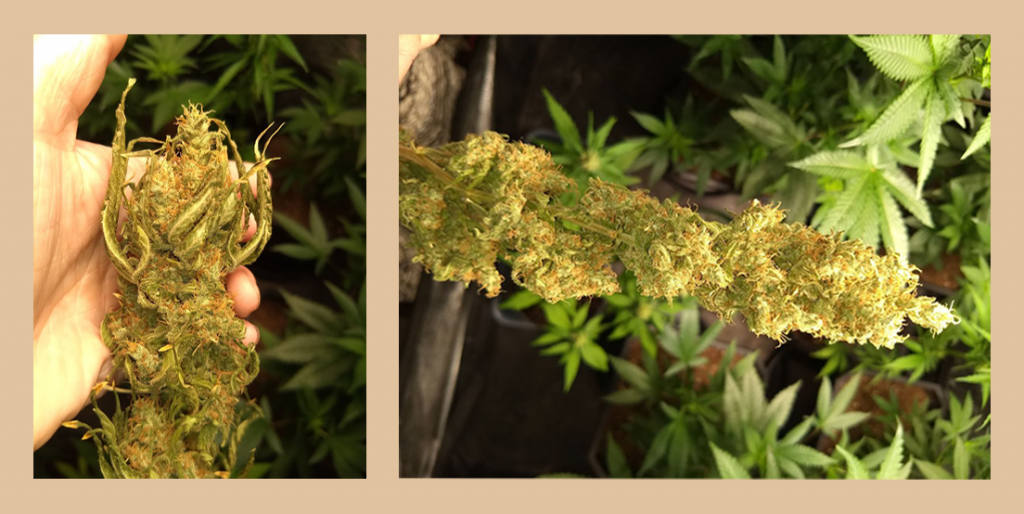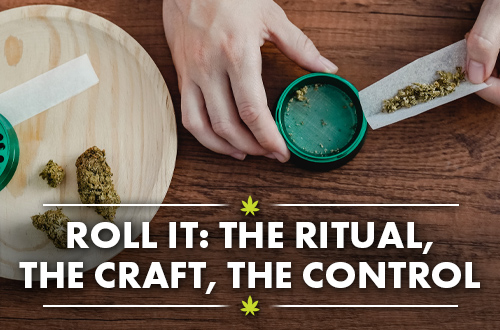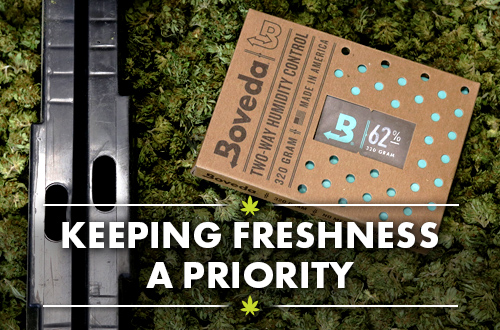Home Grow chronicles Dianna’s personal journey as a medical cannabis patient who registered and was approved by the Canadian government to grow cannabis in her home. Dianna’s experience is one grower’s point of view. Her ideas are neither the best nor the only proven methods for growing medicinal grade cannabis.
It’s harvest time for indoor cannabis cultivator/Boveda blogger Dianna Donnelly! Learn why after wet-trimming her first crop, she’ll dry trim her flower next time around. What’s right for you?
It’s harvest time for my home grown beauties! Time to pull down my first crop of medicine. I decided to wet trim my first cannabis harvest. When you wet trim cannabis, you remove and trim the sugar leaves from flower immediately after you cut her from the mother plant.
Wet trimming can be easier for new growers like me since it’s pretty easy to work your way around the plant snipping off full stems of leaves. The buds and leaves hold a lot of moisture, which is why it’s called wet trimming. Because I’m a hands-on, over-protective mother of my green, I imagined coddling those sticky buds like the newborns that they were. So I wet trimmed my first harvest—all three green goddesses in one pain-staking, back-aching, sneeze-filled afternoon. And it was hard, messy labor.
—as fresh as it gets. “Edward Scissorhandsing” buds this fresh let’s you vary your trim— from loose to very, very tight. You can sculpt the bud to what you want. Depending on the cultivar or strain, a specific trim can make a small cola look big and meaty. Personally, I did not enjoy wet trimming my home grow.
With itchy arms and wet fingers, I stopped halfway through the wet trim and whined, “Are we there yet?!”
What surprised me immediately was the goo that splashed onto my hands and fingers. This is a kind of plant-mucilage. No doubt the very essence that flows from root to stoma during transpiration. But holy-mother-of-cannabis, it was cold, slimy, and after a while, itch-inducing, too.

At times, if I cut too deeply into the bud, it felt like I was chopping some exotic form of vegetation for a salad. The cannabis plant would be well over 90% water at this point—as fresh as it gets. “Edward Scissorhandsing” buds this fresh let’s you vary your trim— from loose to very, very tight. You can sculpt the bud to what you want. Depending on the cultivar or strain, a specific trim can make a small cola look big and meaty. Personally, I did not enjoy wet trimming my home grow.

As we all know, the magic happens inside those botanical crystal balls known as trichomes. Trichomes are where THC, terpenes and other cannabinoids form. While growing and freshly cut, the trichome is delicate as is the thin “skin” that protects its contents. Cannabis starts to degrade immediately after harvest. Wet-trimmed flower dries quickly—in two to five days—because you’re fully exposing those naked buds to oxygen and the natural process of evaporation. So it’s important to keep an eye on the bud’s moisture content or you’ll damage your delicate trichomes.
After trimming, I hung up my buds in my closet to dry. I kept a fan running to circulate the air. Another way to dry wet trim is to lay those flowers in an individual layer on a mesh screen or flat, breathable drying rack. If you’re handy, you can build a frame to stack your racks vertically.
Another way to dry wet trim is to lay those flowers in an individual layer on a mesh screen or flat, breathable drying rack. If you’re handy, you can build a frame to stack your racks vertically.
HOW THE PROFESSIONALS TRIM THEIR HARVEST
Today, most North American producers trim cannabis using machines. Automating the trim drastically lowers labor costs because it’s quicker. Trimming machines suck in branches and spit buds out the other side. To be honest, watching a plant pass through a machine trimmer rips my guts out. But I’m a home grower with just a few, not rows and rows, of plants to harvest
Automated trimming makes sense when you have to buck a lot of cannabis in a short amount of time. The Twister B4 replaces the work that crews of 10 to 15 used to do by hand. And one unit can process more than 65 kg (≈ 150+ lbs) of fully hydrated cannabis per hour.
There are smaller bucking and trimming machines designed for home growers. The small-capacity Twister T6 dry bucks almost 2 kilograms (≈ 4 lbs) per hour or wet bucks 9 kilograms (≈ 20 lbs) per hour. At just shy of $3,000 USD, the tabletop model is still way too rich for my blood.
WHY I SWITCHED FROM WET TO DRY TRIMMING MY HOME GROW
I dry trimmed my second harvest and have never looked back because it:
- Eliminated itch-inducing fluids from oozing all over my hands and arms
- Retained leaves that create a “natural humidor-like effect” for flower, slowing evaporation by protecting the flower and its cannabinoids
- Used gravity to slowly draw remaining moisture down into the flower
5 STEPS TO HANG DRYING CANNABIS
- Ten days before harvest, trim off the larger fan leaves. Defoliation of extraneous leaves is a technique I’ve practiced all along. And defoliating the plants right before I pulled them down saved trim time on the back end. The leaves’ time, after all, has passed and they are no longer needed.
- Choose to:
– Harvest cut 30-45 cm (12 to 18 inches) long stalks from the plant or
– Cut down the whole plant, snipping as close to the soil as possible - Cut fast when you cut into the plant, so transpiration doesn’t pull fluids from the roots into the buds again.
- Immediately hang the plant or stalk upside down temporarily from something like a clothes rack.
- Move harvested plants or stalks to their drying area, then hang them upside down on a clothes lines or fishing line for up to 10 days. (Leave some space between plants, so air can circulate around them while they dry. )

My stalks dried in the closet where their mother plants started their lives with me. These cannabis branches dried too rapidly in just five days. A slow, careful dry is crucial to attain a full-bodied, fully effective bud of medicine.
The fix?
Run a cool mist humidifier in the closet to raise the humidity level and slow the drying process. Raising the humidity level lengthens the time for my medicine to mature its complex compounds in a process “cannabinoid biosynthesis.”
Cannabinoid biosynthesis is how cannabinoids are made. In the veg stage, many of the therapeutic compounds in cannabis do not yet exist. Slow drying coaxes the water out of the flowers in a controlled method, which leaves the active compounds intact. Once the water content is lowered, further cannabinoid conversion occurs. Rapid water evaporation, however, robs your medicine of many of the water-bound terpenoids that flavor your flower.
HOW TO TELL IF THAT HANGING CANNABIS IS SUFFICIENTLY DRY
Anecdotally, I’ve read that a cannabis stalk will snap when it’s dry and ready to cure. For me that is just too vague. Admittedly, I over-dried my harvest because I fear the microorganism.
Microorganism growth of mold, mildew and other fungus begins at 65% relative humidity (RH). You can imagine the dangers of bottling overly humidified buds for cannabis patients like me. Before risking your whole harvest to mold, you need to test the relative humidity (RH) of your dried flower with a digital hygrometer.
HOW TO KNOW IF CANNABIS IS READY TO CURE
- While they are drying, snip a few of the largest buds.
- Put those buds and a calibrated digital hygrometer into an airtight container, like a jar or CVault®.
- After 24 hours, check the RH reading of the cannabis hygrometer
- If your reading is greater than 55% RH, your flower needs more time to dry.
- Dry for a few more days and then repeat the test until your dried cannabis reaches 55% RH.

Trim off remaining leaf matter while the plants are still hanging, so you can see where the sugar leaf stems meet the flower. This makes it easy to remove those leaves without disrupting many of the now hardened trichomes. The dried trichome’s now hardened state ensures the bulbous head remains intact but is precariously brittle—handle with care and always trim with a clean tray to catch falling trichs!
ON TO THE CURE
At this part in my home grow journey, I’m as proud as a farmer under a harvest moon. Just as any traditional farmer must process and preserve harvested vegetables and fruits to extend their shelf life, so does a cannabis grower. Curing is how growers preserve and age cannabis. But that’s a topic for next month.

Dianna Donnelly is a cannabis educator, blogger, and freelance writer living in Kingston, Ontario. She counsels new patients on the safe and effective use of medicinal cannabis and believes that with enough time, cannabis, and coconut oil she can heal the world.
Dianna Donnelly’s posts are being provided for informational purposes only; they do not constitute an endorsement or an approval by Boveda or any of the products, services or opinions of Dianna Donnelly. Boveda bears no responsibility for the accuracy, legality or content of this post or links to the posts. Contact Dianna Donnelly for answers to questions regarding her content.
Home Grow #12: 3 Reasons to Flush Cannabis Pre-Harvest
Home Grow #14: How to Save the Terps While You Cure








